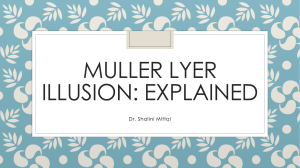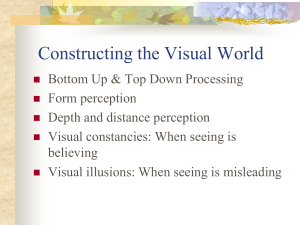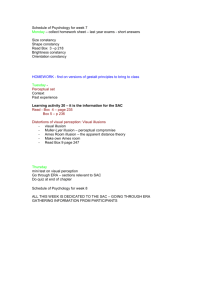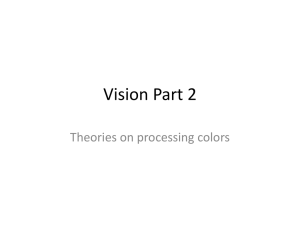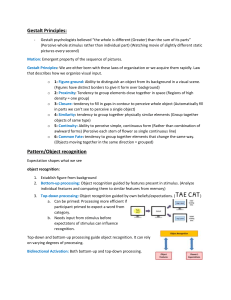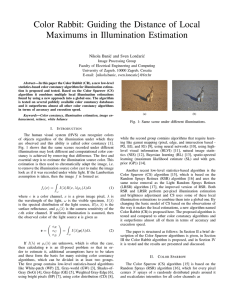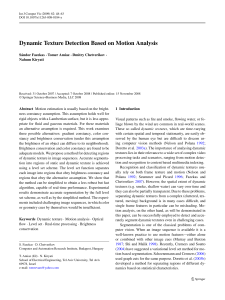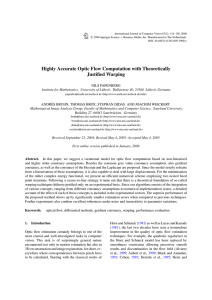Chapter 6 Section 2: Vision
advertisement
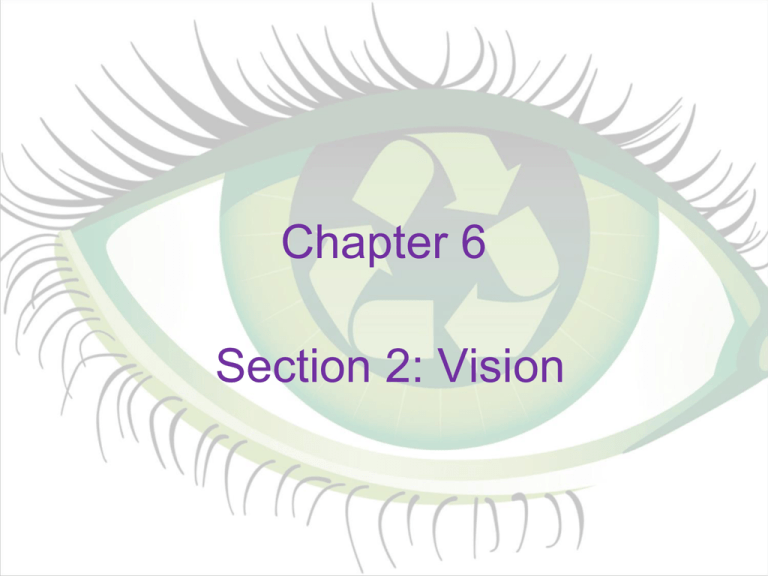
Chapter 6 Section 2: Vision What we See • Stimulus is light –Visible light comes from sun, stars, light bulbs, & is reflected off objects –Travels in the form of waves & these waves affect 3 psychological aspects of our visual world What We See • Hue: The dimension of visual experience specified by color names & related to the wavelength of light. • Saturation: Vividness or purity of color –The dimension of visual experience related to the complexity of light waves. • Brightness: Lightness & luminance –Intensity corresponds to the amplitude of the wave • More light an object reflects, the brighter it appears –The dimension of visual experience related to the amount of light emitted from or reflected by an object. Structures of the Human Eye • Lens subtly changes shape to focus light from objects that are close or far away • The amount of light that gets into the eye is controlled by muscles in the iris • Visual receptors are located in the back of the eye (retina) • Rods: Visual receptors that respond to dim light. • Cones: Visual receptors involved in color vision. • Dark Adaptation: The process by which visual receptors become maximally sensitive to light. • Where the optic nerve leaves the eye, there are no rods or cones, creating a blind spot –Unaware of it because • Image projected on the spot is hitting a different “nonblind” spot in the other eye • Our eyes move so fast we can pick up the complete image • Our brain fills in the gap • Activity page 185 • It’s the brain’s job to take fragmentary information about lines, angles, shapes, motions, brightness, texture, & patterns to figure out that a chair is a chair How we see Colors • Trichromatic Theory –The eye detects 3 primary colors • Red, blue, & green –All other colors can be derived by combining these three Opponent-Process Theory • Assumes that the visual system treats pairs of colors as opposing or antagonistic. • Opponent-Process cells are inhibited by a color, & have a burst of activity when it is removed. • Example page 186 Constructing the Visual World • Form Perception –To make sense of the world, we must know where one things ends & another begins Gestalt Principles • Means “form” or “configuration” • “The whole is more important than the sum of its parts” • People always organize the visual field into figure & ground –Figure stands out from the rest of the environment –Lower part of a scene tends to be seen as figure, upper part as background • Gestalt principles describe the brain’s organization of sensory building blocks into meaningful units and patterns. –Proximity- things that are near each other, tend to be grouped together –Closure- brain tends to fill in the gaps in order to perceive complete forms –Similarity- things that are alike in some way tend to be perceived as belonging together –Continuity- lines & patterns tend to be perceived as continuing in time & space • Quiz • LIVE!Psych Depth and Distance Perception • Binocular Cues: Visual cues to depth or distance that require the use of both eyes. –Convergence: Turning inward of the eyes, which occurs when they focus on a nearby object –Helps us establish distance up to 50 ft –Retinal Disparity: The slight difference in lateral separation between two objects as seen by the left eye and the right eye. • Monocular Cues: Visual cues to depth or distance that can be used by one eye alone. –Linear perspective page 190 & 191 Visual Constancies: When Seeing is Believing • Perceptual constancy- ability to perceive objects as stable or unchanging even though the sensory patterns they produce are constantly shifting –Shape constancy –Location constancy –Size constancy –Brightness constancy –Color constancy Visual Illusions: When Seeing is Misleading • Illusions are valuable in understanding perception because they are systematic errors. –Illusions provide hints about perceptual strategies • In the Muller-Lyer illusion (above) we tend to perceive the line on the right as slightly longer than the one on the left. Fooling the Eye • The cats in (a) are the same size • The diagonal lines in (b) are parallel • You can create a “floating fingertip frankfurter” by holding hands as shown, 510” in front of face.


